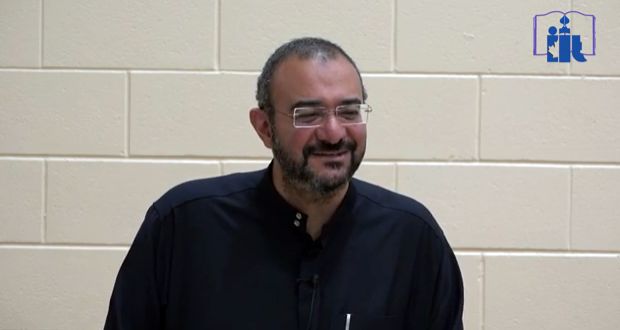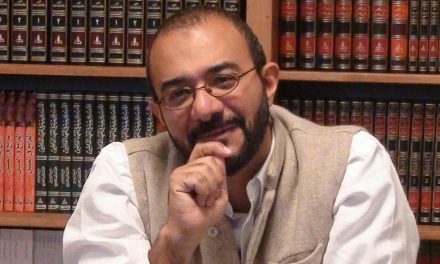Jasser Auda, a Visiting Professor of Islamic Law at Carleton University in Ottawa and a Founding and Board Member of the International Union of Muslim Scholars, claims that there is no basis in Islam for legalizing early marriage.
In his recent lecture on the book of the medieval Andalusian Muslim polymath Averroes (Ibn Rushd) “Distinguished Jurist Primer (Bidayat Al-Mujtahid)”, Auda opined that Aisha married Mohammad, the Prophet of Islam, when she was 16 or 17 years old, and not 9 years old.
The following is an excerpt from Auda’s lecture at the Islamic Institute of Toronto (Published on September 30, 2016):
“The ummah [nation] of Mohammad, peace and blessing of Allah be upon him, is defined by following Mohammad, peace and blessing of Allah be upon him, and following Mohammad means to follow his Shariah [Islamic Law]. So the Sharia is the core identity of this Ummah[Muslim nation]…
“He [Averroes] mentioned things in the family law that has to do with forcing girls to marry by the custodian [wali – والي].
“Even though he disputed the institution of wali to start with, he said that the wali though could enforce the girl, the young [اجبار الصغيرة على الزواج], that the young girl could be forced to marry somebody, and he cited hadith [narration attributed to] Aisha [the youngest of Mohammad’s wives], may Allah be pleased of her, when she was 9 when [she] married the Prophet, peace and blessing of Allah be upon him.
“I think that all of this is wrong, and I take the opinions that Aisha, may Allah be pleased of her, was 16 when she married the Prophet, peace and blessing of Allah be upon him, because shehad converted to Islam with Abu Bakr [her father – اسلمت مع ابيها].
“There is another narration, yes I know, both narrations are in the reliable books of hadiths[صحاح] and in fact, the 9 and 7 narration is more authentic than the narration that she converted with her father when she was 5 or 5 and then 11 years later, she married the Prophet, peace and blessing of Allah be upon him, in Medina.
“But I think that based on what I understand is the spirit of Islam, and knowing that a 9 year old is really small, unless you know humanity was very different at that time, which we really have no evidence for, biologically speaking, that 14 hundred years a 9 year old was like a 16 or 18 year old today.
“I don’t think that this had happened and therefore personally I object to this in his fiqh[jurisprudence] and I think that the opinion that talks about Aisha, may Allah be pleased of her,the historical evidence of her being 16 or 17, to me is evidence that makes sense and is compatible with what Islam is about.
“I don’t care about the the laws, the laws, yes, we have to respect them, but they don’t define the Shariah [Islamic Law]. The Sharia is defined from within, from the hadith and the Quran. We don’t define the Shariah based on the law. So I’m not sure what the law is saying here about the marriage age. Yes, we should respect that, because we are citizens of this country, but in terms of the Shariah, I think that the opinion that she was much later in her life 16 or 17 is better.”
Abu Ameenah Bilal Philips, a Canadian scholar and imam, argues that Aisha married Mohammad when she was 9 years old. Nine years in lunar year, the minimum age according Islam for girl to marry, is in fact 8 years and nine months in solar year, as the lunar year is shorter by 11-12 days of the solar year.
In his book “Contemporary Issues” from 2002, which was accessible for downloading in the online library of the website Muslims of Calgary, Bilal Philips among other things justified the rationale of early marriage in Islam. The following are excerpts from Bilal Philips’ book:
“CHILD MARRIAGES
“The Prophet (PBUH) has been accused of being a pedophile due his marriage to Aa’ishah at the age of 9…
“3. Islam sets the age of marriage at puberty, as it is the natural dividing line between childhood and adulthood. Menstruation indicates that a young girl has reached childbearing age. This age may vary from country to country, but it is discernible and not arbitrary…
“5. Islam stipulates that a girl or boy married before puberty will not live with their spouse until they have attained puberty. Furthermore, they have the right to cancel or proceed with the marriage when they reach puberty.
“6. Aa’ishah was seven when she was married off to the Prophet (PBUH) and she came to live with him when she reached puberty at nine…”
Canadian Shiite Imam: Muslim girls are eligible for marriage at the age of 8 years and 9 months
Sayyid Muhammad Rizvi, the Imam of the Islamic Shia Ithna Asheri Jamaat of Toronto and the Jaffari Islmic Centre in Thornhill Woods, discusses in his book “Marriage and Morals in Islam” the Islamic law and rulings regarding to the age of puberty and early marriage.
The followings are excerpts from chapter three “The Islamic Sexual Morality (2) Its Structure”:
“Sexual desire is aroused in human beings at the age of puberty. In Islamic legal definition puberty (bulugh) is determined by one of the following: 1. age: fifteen lunar years for boys and nine lunar years for girls…”
“Since the sexual urge begins at puberty and as Islam says that sexual urge should be fulfilled only through marriage, it has allowed marriage as soon as the boy and the girl reach the age of puberty. In the case of girls, it not only allows them to be married as soon as they become mature, but also recommends such marriage. It is based on such teachings that Islam discourages girls from postponing their marriage because of education; instead, it says that girls should get married and then continue their education if they wish to do so.”
“Physical maturity by itself, however, is not enough for a person to handle the marriage responsibilities; rushd (maturity of mind) is equally important…”
“If a person does not marry soon after maturing and finds it difficult to control his or her sexual desire, then the only way to fulfill the sexual desire is mut’a.”
“In Islamic laws, according to the Shi’ah fiqh, marriage is of two types: da’im, permanent and munqati’, temporary. The munqati’ marriage is also known as mut’a…”
“I cannot overemphasize the temporary nature of mut’a. The message of Islam is quite clear: marry on a permanent basis; if that is not possible, then adopt temporary abstinence; if that is not possible, only then use the mut’a marriage.”
These Islamic rulings regarding the age of puberty are being taught in Islamic schools in North America. For instance, the textbook for 7 Grade students of the Islamic Shia Study Centre West Madrasah (ISSC) in Brampton, Ontario explains the definition of puberty in Islam, and consequently the duties (wajib) applicable to all mature males and females.
The following is an excerpt from “Lesson 6 Gender-Specific (for Girls)” appears on page 100 of the aforementioned textbook which also appeared on the site of :
“Signs of Bulugh
As boys and girls grow into men and women, they change physically and emotionally. This age of maturity is also called the age of puberty (or bulugh in Arabic). Boys mature (become bāligh) closer to the ages of 13-15 years. Girls mature earlier and in Islām are considered to be bāligha from the age of 9 (i.e. on her 9th Islāmic birthday). This means whatever is wājib on adults like praying (salāh), fasting (sawm) and hijāb is also wājib on a Muslim girl from the age of 9.”
Reference: http://en.cijnews.com/?p=49510



 RTP SLOT GACOR GARANSI KEKALAHAN 100% BEBAS IP
RTP SLOT GACOR GARANSI KEKALAHAN 100% BEBAS IP LINK SLOT GACOR SLOT GACOR MAXWIN PRAGMATIC PLAY TERPERCAYA
LINK SLOT GACOR SLOT GACOR MAXWIN PRAGMATIC PLAY TERPERCAYA Daftar login Link Official Gaming Server Luar Slot Gacor
Daftar login Link Official Gaming Server Luar Slot Gacor LINK LOGIN situs_terpercaya situs slot terbes
LINK LOGIN situs_terpercaya situs slot terbes

